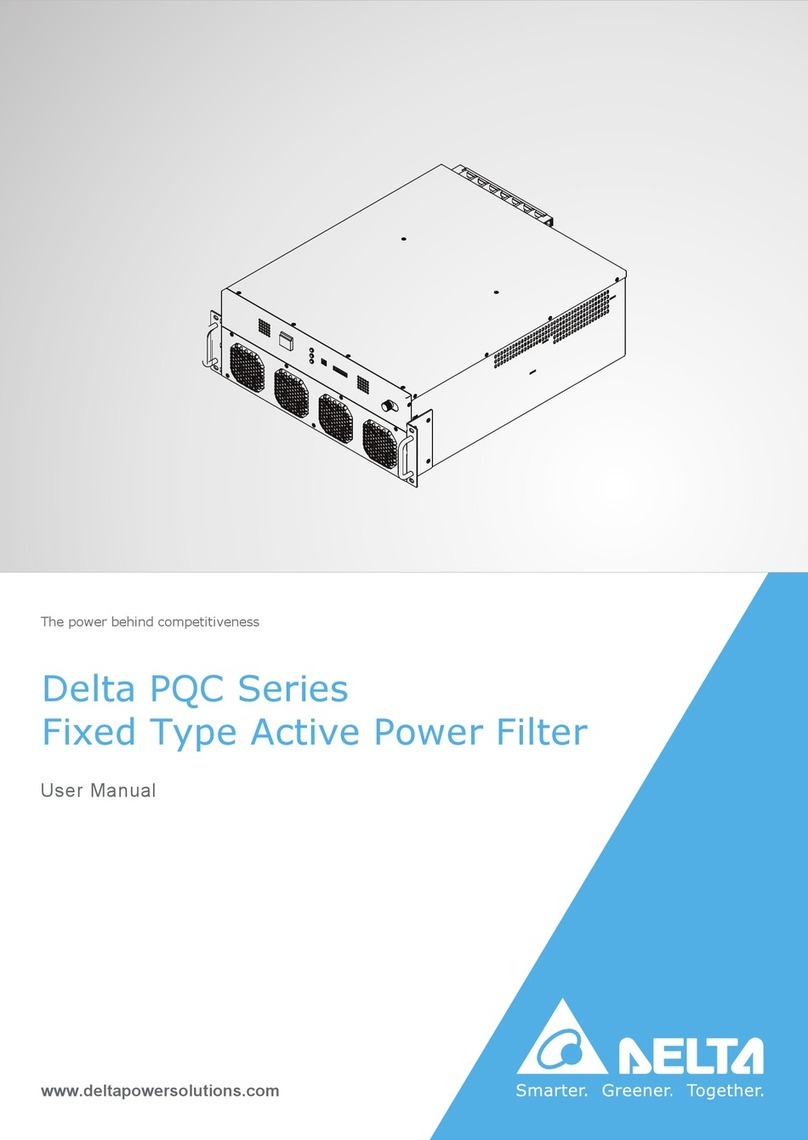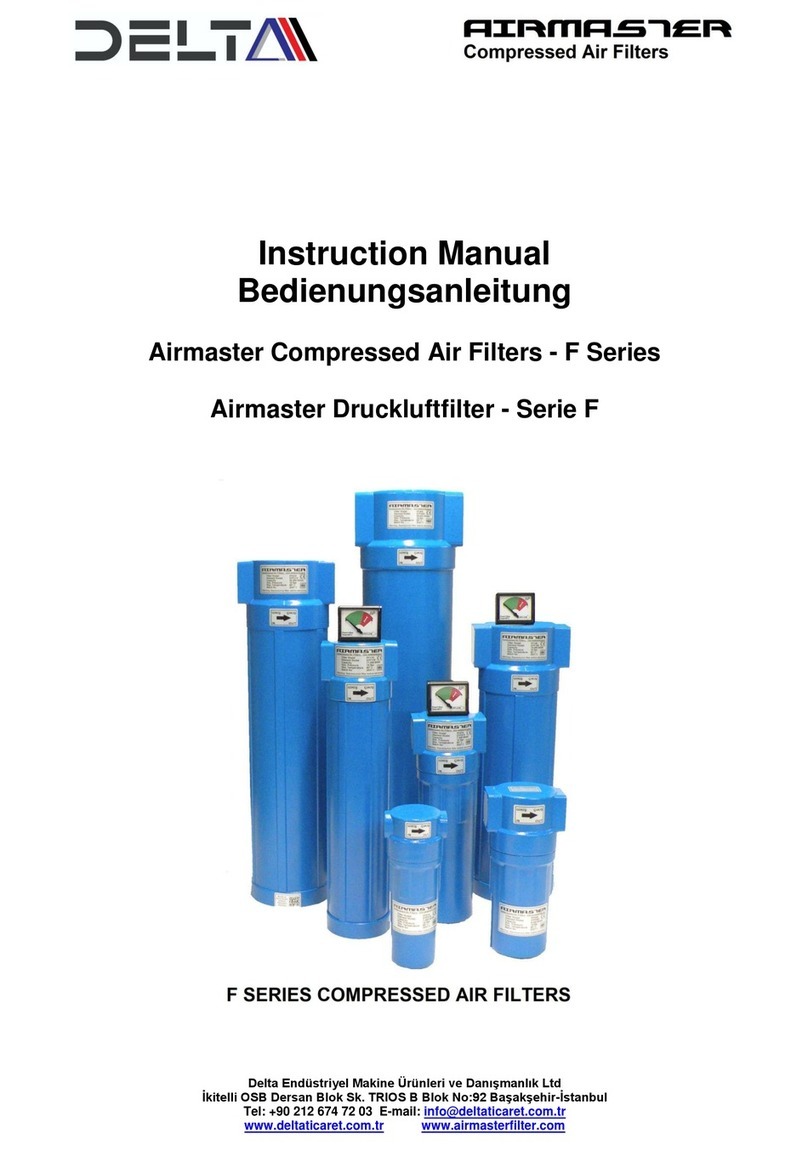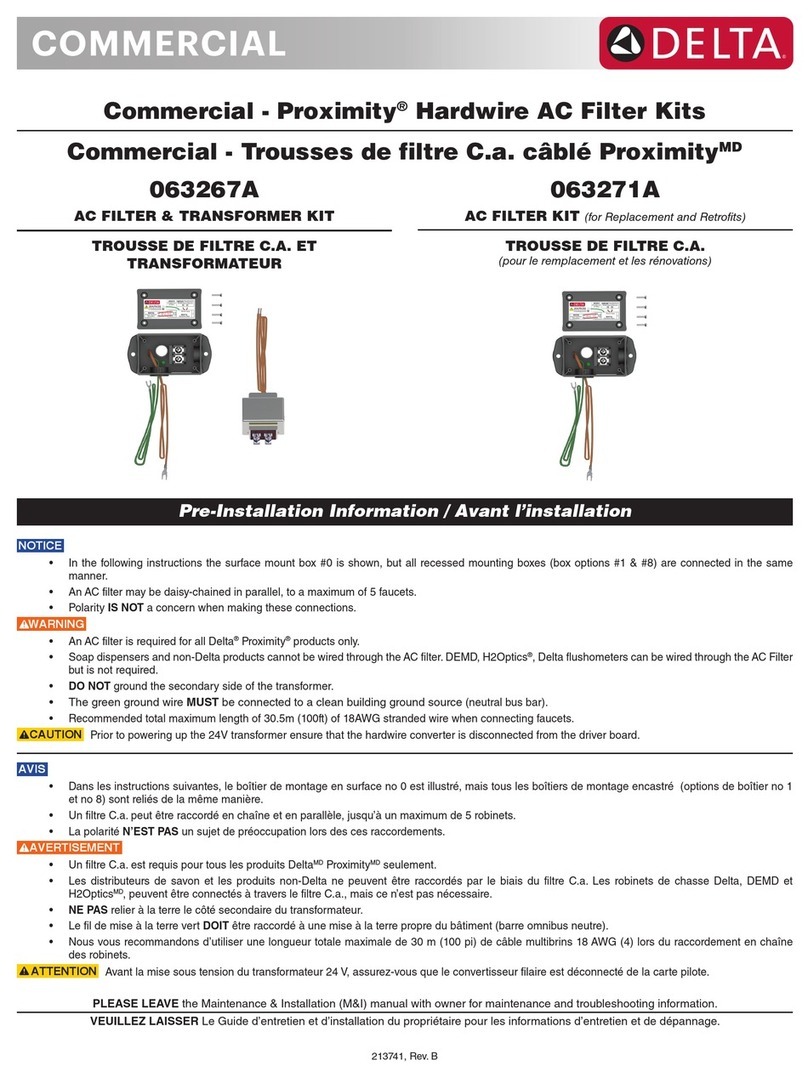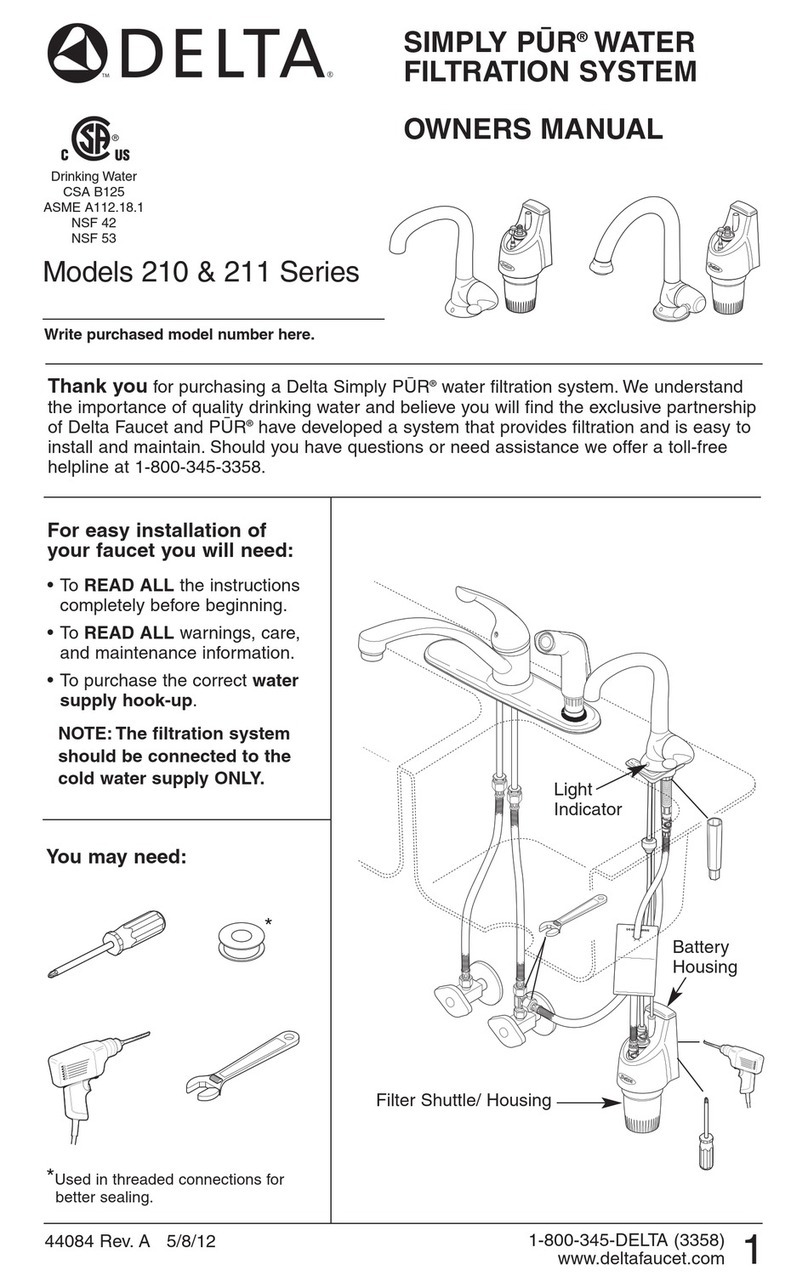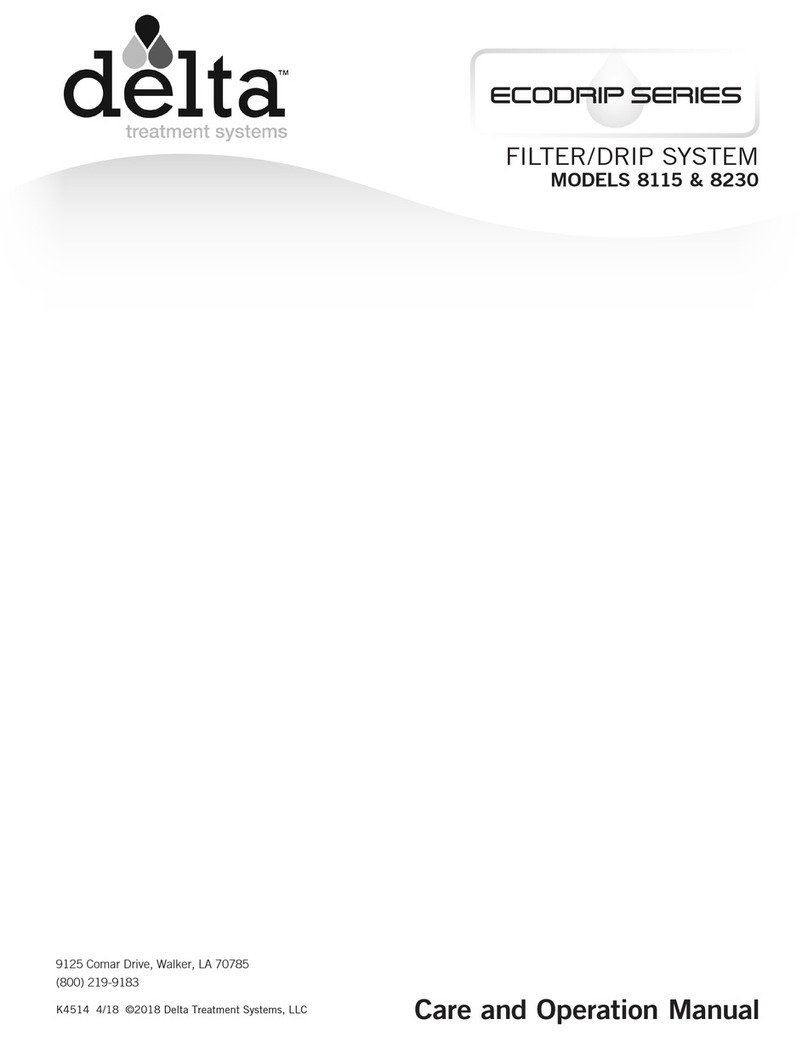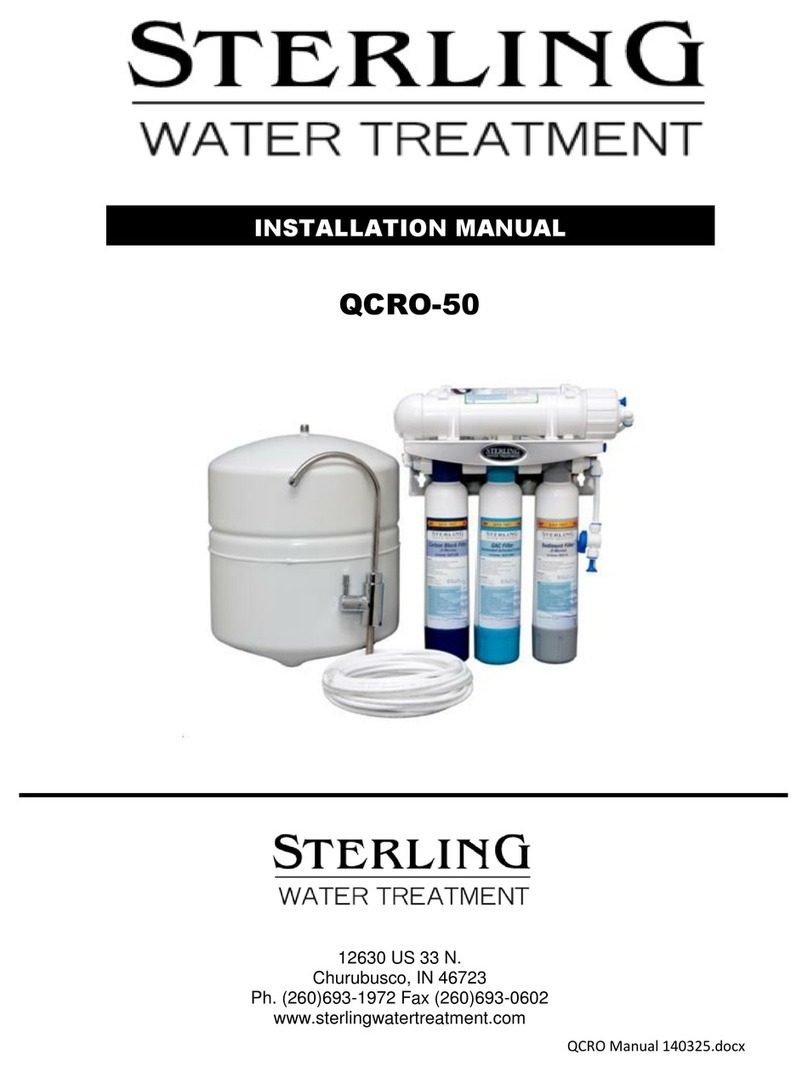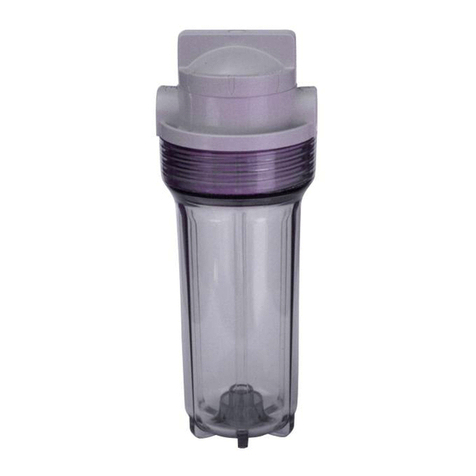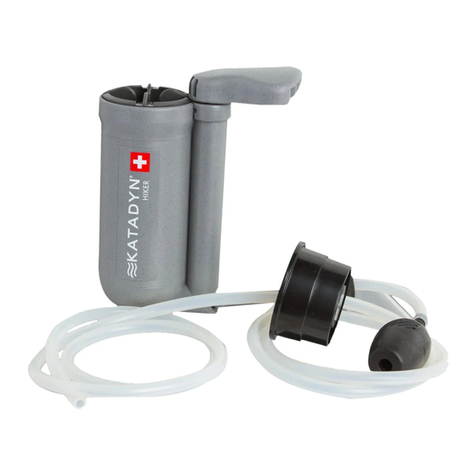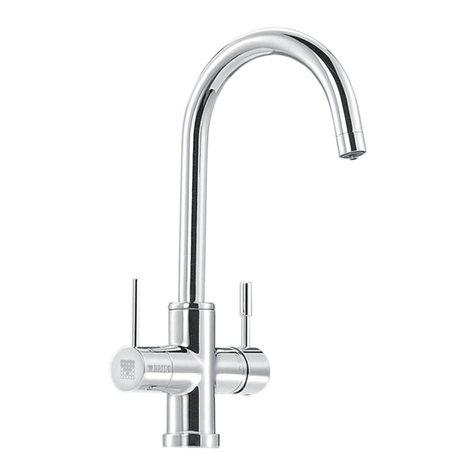Delta PQC Series User manual

Delta PQC Series
Active Power Filter
The power behind competitiveness
www.deltapowersolutions.com
User Manual

II
PQC Series Active Power Filter
Save This Manual
This manual contains important instructions and warnings that you should follow
during the installation, operation, storage and maintenance of this product. Failure
to heed these instructions and warnings will void the warranty.
Copyright © 2015 by Delta Electronics Inc. All Rights Reserved. All rights of this User Manual
(“Manual”), including but not limited to the contents, information, and figures are solely owned and
reserved by Delta Electronics Inc. (“Delta”). The Manual can only be applied to the operation or the
use of this product. Any disposition, duplication, dissemination, reproduction, modication, translation,
extraction, or usage of this Manual in whole or in part is prohibited without the prior written permission
of Delta. Given that Delta will continuously improve and develop the product, changes may be made
to the information in this Manual at any time without obligation to notify any person of such revision
or changes. Delta will make all possible efforts to secure the accuracy and the integrity of this
Manual. Delta disclaims any kinds or forms of warranty, guarantee, or undertaking, either expressly
or implicitly, including but not limited to the completeness, faultlessness, accuracy, non-infringement,
merchantability or tness for a particular purpose of the Manual.

III
Table of Contents
Table of Contents
Chapter 1 : Important Safety Instructions ---------- 1
1.1. Safety Precautions ------------------------------------------------------------------ 1
1.2. Wiring Warnings --------------------------------------------------------------------- 1
1.3. Usage Warnings --------------------------------------------------------------------- 2
1.4. Storage Precautions ---------------------------------------------------------------- 2
1.5. Symbols-------------------------------------------------------------------------------- 2
Chapter 2 : Introduction ---------------------------------- 3
2.1 Product Introduction ---------------------------------------------------------------- 3
2.2 PQC Series APF Wall-mounted Module Category-------------------------- 4
2.3. Functions & Features---------------------------------------------------------------------- 6
2.4. Mechanism & Appearance -------------------------------------------------------- 7
2.4.1 Wall-mounted Module Appearance and Dimensions----------- 7
2.4.2 LCM (Liquid Crystal Monitor)----------------------------------------- 9
2.5. Package Inspection ----------------------------------------------------------------11
Chapter 3 : Installation and Wiring-------------------12
3.1 Pre-installation Conrmation ----------------------------------------------------12
3.2 Installation Environment ----------------------------------------------------------12
3.3 Installation of the Wall-mounted Module--------------------------------------14
3.4 Installation of the LCM ------------------------------------------------------------15
3.5 Wiring of the Wall-mounted Module -------------------------------------------16
3.6 CT Installation & Wiring for Current Detection of Harmonic Source---16
3.6.1 CT Selection Precautions --------------------------------------------16
3.6.2 Basic CT Installation & Wiring --------------------------------------18
3.7 Wiring for the Communication Terminals -------------------------------------19
Chapter 4 : APF Operation Procedures-------------20
4.1 Inspection Before Start-up -------------------------------------------------------20
4.2 Start-up Procedures ---------------------------------------------------------------21

IV
PQC Series Active Power Filter
Chapter 5 : LCM Display and Settings --------------22
5.1 Description of LCM Display ------------------------------------------------------22
5.2 LCM Display Hierarchy -----------------------------------------------------------23
Chapter 6 : Maintenance---------------------------------24
Chapter 7 : Troubleshooting ---------------------------25
Chapter 8 : Warranty --------------------------------------26

1
Chapter 1 Important Safety Instruction
Chapter 1 : Important Safety Instructions
1.1. Safety Precautions
yy The active power lter (‘APF’) shall be connected with a power grid system and in parallel
with harmonic sources (i.e. nonlinear loads) as a means to control harmonics.
yy The APF shall not be exposed to rain or wet conditions, and shall be away from any am-
mable uid, gas or explosives.
yyAdequate space shall be left at the top and bottom of the APF for well ventilation and con-
venient maintenance.
yy To minimize re and electric shock hazards, installation must be conducted by qualied
service personnel in a controllable working environment.
yy To minimize electric shock hazards, all maintenance work must be carried out by qualied
technician. Before maintenance, ensure that all power supply is completely cut off.
yyHigh voltage hazards! It takes over 15 minutes for the DC capacitor to discharge. Please
make sure the device has discharged completely before carrying out any operation.
yyTo minimize electric shock hazards, please read this Manual carefully before switching
the power on, and keep this Manual properly for permanent reference.
yyWhen the APF is used in IT applications, please install an insulation resistance detection
device so that the alarm will go off when a protection earth fault is detected.
1.2. Wiring Warnings
yyTo prevent a possible risk of current leakage, the APF shall be earthed properly.
yyWith regard to wiring, the compensation capacity and the current-carrying capacities of
cables shall be taken into account.
yyThe incoming lines of the APF shall be connected with appropriate protective devices. It is
recommended to provide every module with an over-current protective device with a third-
party certication: rated voltage 400V and rated current 125A. Besides, take the installa-
tion position of the equipment into consideration and choose the protective devices with
adequate breaking capacity.
yy The capacity of the protective device shall t that of the APF.
yyTo prevent scaling caused by high temperature, after the power is cut off, the operating
switch shall be allowed to cool down before being operated again.
yyThe three-phase, four-wire APF is applicable to the power grid system with neutral
grounding.

2
PQC Series Active Power Filter
1.3. Usage Warnings
yySince the APF is used for harmonic compensation of the power grid, the capacity selec-
tion of the APF shall be subject to the harmonic content to avoid poor compensation due
to insufcient capacity.
yySince the APF is used for harmonic control, it shall be connected to an external CT for
current detection (CT: Current transformer).
yyTo guarantee sound reliability and avoid overheating, do not block or cover the air inlet
and outlet of the APF.
yyThe working temperature range of the APF is -10°C - 50°C, beyond which the APF will not
work.
yyWhen installation, ensure that the height from the ground to the top of the APF is not less
than 1800mm. After installation, ensure that no objects are placed on the APF’s air outlet;
otherwise, the objects might drop into the air outlet to inuence the APF ventilation and
operation.
1.4. Storage Precautions
yyPlease use the original packing material to protect the APF in order to avoid damage by
rodents.
yy If you don’t install the APF immediately after receiving it, please store the APF in a dry
and ventilated indoor place, where shall be maintained between -40°C and 70°C with
relative humidity no higher than 95%.
1.5. Symbols
Item Symbol Meaning
1R Phase R of three-phase power supply
2S Phase S of three-phase power supply
3T Phase T of three-phase power supply
4N Neutral line
5Main grounding terminal
6E.P.O button

3
Chapter 2 Introduction
Chapter 2 : Introduction
2.1 Product Introduction
The active power lter ('APF'), a harmonic compensator for the three-phase power grid, is
applied to the harmonic control of the power grid. Features of the device are shown as below:
yy Compensates a wide range of harmonic frequency and any specied harmonic.
yyRapid dynamic responses, stable parameters and good harmonic compensation results.
yy High efciency and low thermal loss.
yyThe system adopts an advanced 3-level structure and consists of digital signal proces-
sors (DSP), large programmable controllers and high power electronic devices, which has
excellent performance and superior reliability.
yySupports remote power on/ off functions via computer monitoring.
Please see
Figure 2-1
for the APF block diagram. The APF system is composed of a wall-
mounted module and a LCM (Liquid Crystal Monitor). The external CT is used for the
detection of load current in the module and extraction of harmonic components, based
on which, the main power controller controls the main power circuit to generate reverse
harmonic current; in this way, the load-carrying harmonic components are counteracted.
Please note that the wall-mounted module and the LCM are packed separately. If you would
like to buy both of them, you should purchase them separately.
The wall-mounted module can work either alone or in parallel with others. The LCM monitors
and controls the wall-mounted module online. If monitoring function is not required, there is
no need to buy and install the LCM.

4
PQC Series Active Power Filter
( Figure 2-1: APF System Block Diagram )
Non-linear load
Single-phase load
Three-phase load
CT
Harmonic
detection of
load current
Main
power
circuit
LCM
Optional Module
APF System
Power grid
Main
power
control
Module
Main
power
circuit
Main
power
control
Harmonic
detection of
load current
2.2 PQC Series APF Wall-mounted Module Category
The PQC series APF product includes the wall-mounted module and the LCM. Table 2-1 lists
the wall-mounted module’s model, capacity and wiring system.
Table 2-1: PQC Series APF Wall-mounted Module Specications
Model Capacity System
PQCA-400-50-50WM3 50A 3P3W
PQCA-400-50-50WM4 50A 3P4W
PQCA-400-50-75WM3 75A 3P3W
PQCA-400-50-75WM4 75A 3P4W
The APF’s wall-mounted module is available in two wiring modes, i.e. 3P3W and 3P4W,
and is available in two specications in terms of the output current, i.e. 50A and 75A. The
3P4W module shall be connected to the neutral line, and it is able to compensate the current
of neutral line, including zero sequence fundamental current and 3rd harmonic current;
however, for the 3P3W module, it is unnecessary to connect the neutral line, and the module
is unable to compensate the current of neutral line, such as zero sequence fundamental
current and 3rd harmonic current. Figure 2-2 shows the APF’s wall-mounted module.

5
Chapter 2 Introduction
174
mm
600
mm
440
mm
( Figure 2-2: PQC Series APF Wall-mounted Module )
Use the provided LCM connection wire (packed in the LCM package) to connect the LCM’s
DATABUS port and the wall-mounted module’s communication terminals. After that, you can
use the LCM to monitor the operation status of the wall-mounted module and set up relevant
parameters. The embedded design of the LCM is convenient for customer to install it on any
of customer provided panel. Figure 2-3 shows the LCM appearance.

6
PQC Series Active Power Filter
2.3. Functions & Features
yy Multifunction: the APF can simultaneously realize the purposes of harmonic, reactive and
three-phase unbalance control.
yy Superior harmonic control effects: up to 97% harmonics of the system can be effectively
ltered.
yy Excellent compensation of reactive power: the device can realize rapid (ms-grade re-
sponse), precise (-0.99< PF< 0.99) and bi-directional (both capacitive and inductive com-
pensations) reactive power control.
yy Outstanding compensation of unbalanced three-phase: the device can realize correc-
tion for either active or reactive unbalance, and can eliminate the neutral current (for the
three-phase four-wire series only).
yyWide input voltage and frequency ranges, suitable for the applications with diesel genera-
tors and harsh power supply conditions, line voltage: 308V ~ 456V.
yy Low power loss (lower than 3% of rated device power) and actual efciency > 97%.
yy Sound stability: the device acts as an innite impedance to the power grid system and
has no effect on the impedance of the power grid system; it is able to produce accurate
and awless output waveform, which has no effect on other equipment.
yy Applicable to all work conditions: the device is able to operate under high temperature up
to 50°C and salt spray corrosive conditions, can withstand grade-9 seismic intensity and
is compatible with the diesel engine generating system.
yy User-friendly interface (in both Chinese and English): event log, automatic fault alarm,
alarm history and other parameter setting functions.
yy Complete functions: automatic self-checking start, settable soft start time, emergency
stop (E.P.O), etc.
( Figure 2-3: LCM )

7
Chapter 2 Introduction
2.4. Mechanism & Appearance
2.4.1 Wall-mounted Module Appearance and Dimensions
( Figure 2-4: PQC Series APF Wall-mounted Module_Front View )
件
E.P.O Button
LED Indicators
ID Dip Switches

8
PQC Series Active Power Filter
(Figure 2-5: PQC Series APF Wall-mounted Module _Side View )
DC Fans
( Figure 2-6: PQC Series APF Wall-mounted Module _Top View )
Communication Terminals
CT Terminals
Main Power Input Terminals
No. Item Meaning
DC Fans Heat dissipation DC fans.
E.P.O Emergency stop button.
LED Indicators
Wall-mounted module’s status indicators:
• Green (normal): Normal.
• Yellow (standby): Standby
• Red (fault): Fault
ID Dip Switches Please refer to Chapter 4: APF Operation Pro-
cedures.
CT Terminals For CT signal.
Communication Terminals For communication signal.

9
Chapter 2 Introduction
No. Item Meaning
Main Power Input Terminals For main power input wiring (R/ S/ T/ N/ PE).
Table 2-2: PQC Series APF Wall-mounted Dimensions & Weight
Model Dimenisions (W*H*D) No.
PQCA-400-50-50WM3 440×600×174mm 41kg
PQCA-400-50-50WM4 440×600×174mm 41kg
PQCA-400-50-75WM3 440×600×174mm 41kg
PQCA-400-50-75WM4 440×600×174mm 41kg
2.4.2 LCM (Liquid Crystal Monitor)
( Figure 2-7: LCM_ Front View )
NORMAL
STANDBY
FAULT
LCD
ON/ OFF
UP
ESC
ENTER
DOWN

10
PQC Series Active Power Filter
No. Item Meaning
NORMAL LED (green) Illuminates when the APF system is normal.
STANDBY LED (yellow) Illuminates when the APF system is in standby status.
FAULT LED (red) Illuminates when the APF system has abnormalities.
LCD Display Displays both Chinese and English fonts.
ON/ OFF Key Press and hold the key for 3 seconds to switch on/ off
the APF system.
UP Key Press the key to move the menu items upward or to
increase the parameter setting value.
ESC Key Press the key to return to the previous menu or to
save the parameter setting when exit.
ENTER Key Press the key to go to the next page or to conrm the
parameter setting.
DOWN Key Press the key to move the menu items downward or
to reduce the parameter setting value.
( Figure 2-8: LCM_ Rear View )
DATABUS
RS232
No. Item Meaning
DATABUS The communication interface between the LCM and
the wall-mounted module.
RS232 The standard RS232 interface.

11
Chapter 2 Introduction
2.5. Package Inspection
NOTE:
The APF includes the wall-mounted module and the LCM, which are packed
separately. If you would like to buy both of them, you should separately purchase
them.
yyExterior
Some unpredictable situations might occur during transportation. It is recommended that
you inspect the exterior packaging after receiving the wall-mounted module and the LCM.
If you notice any damage, please contact your supplier.
yyInterior
1. Please check the rating labels of the wall-mounted module and the LCM to see if the
products conform to your order.
2. Please check if any parts are damaged or loose.
3. Please check if the accessories are complete.
4. Please see the tables below for the standard accessories of the wall-mounted module
and the LCM.
Table 2-3: Standard Accessories of the Wall-mounted Module
No. Item Quantity
CT Terminal Block (3-pin) 2 PCS
Communication Terminal Block (6-pin) 2 PCS
Main Power Input Terminal_ R/ S/ T/ N 4 PCS
PE Terminall 1 PC
Terminal Screw M6*12L 5 PCS
Table 2-4: Standard Accessories of the LCM
No. Item Quantity
LCM Connection Wire 1 PC
Fastening Screw 4 PCS
5. If any damage is found, please contact your supplier.
6. To return goods, please use the original packing material to pack the wall-mounted
module, the LCM and all standard accessories.

12
PQC Series Active Power Filter
Chapter 3 : Installation and Wiring
The APF is applicable to many applications and can meet the particular installation requirements
of industrial sites, power distribution rooms and computer rooms. The wall-mounted module can be
installed on a load-bearing wall or in a cabinet.
3.1 Pre-installationConrmation
Since the installation environment varies for different users, please be sure to read this
Manual carefully before installation. All installation, assembly and start-up work must be
carried out by qualied professional personnel. If you want to carry out installation, assembly
and start-up work by yourself, it shall be under the supervision of qualified professional
personnel.
3.2 Installation Environment
1. The APF device can only be installed indoors. Do not install the device for outdoor use.
Be sure to consider the IP21 protection degree of the device while installing. For a higher
protection degree requirement, please contact your distributor.
2. The APF device shall not be installed in a place close to dust sources or subject to heavy
environmental pollution. Since the conductive dust will damage the device, make sure the
installation place is free of conductive dust.
3. Make sure that the installation and supporting components are capable of bearing the
weight of the APF.
4. Since some noise can be generated during the operation of the APF, please take the
noise effects into account when choosing the installation position.
5. Keep the installation area clean. Please note that wiring routes must be hermetic to
prevent possible damage from rodents.
6. Make sure that enough space is left in the installation area for maintenance. When
installation, ensure that the height from the ground to the top of the APF is not less than
1800mm. This avoids any object from being placed on the top of the APF and from
dropping into the APF.
7. Since some heat can be generated during the operation of the APF, please make sure the
cooling system of the installation environment is sufcient for heat dissipation, so that the
ambient temperature will not exceed the normal working temperature of the device.
8. The device is equipped with cooling fans, and is designed with air inlet at the bottom and
air outlet on the top as well as on the sides; thus, it is recommended to leave at least a
500mm space both on the top and at the bottom, and some ventilation space on the sides
of the APF for ventilation purpose. Figure 3-1 illustrates the air inlet & outlet schematic
diagrams of the APF.

13
Chapter 3 Installation and Wiring
( Figure 3-1: Air Inlet & Outlet Schematic Diagrams of the APF )
件
9. The APF has a minimum vent flow requirement, which shall be met to guarantee the
normal cooling of the device. For the APF mounted in a cabinet, please ensure the
cabinet has sufcient vent ow to cool the device.
10. The working temperature range of the APF is -10°C ~ 50°C, beyond which the APF will
not work.
11. Do not use the device in a place above an altitude of 1000m. If such an installation place
cannot be avoided, please consider de-rating of the device, or contact your distributor.
12. The APF’s main power input terminals are covered by the protection covers. Before
removing the protection covers or wiring, please ensure that the power is off. Before
powering on, make sure the protection covers are re-installed.

14
PQC Series Active Power Filter
3.3 Installation of the Wall-mounted Module
When the wall-mounted module needs to be installed in a cabinet, ensure that the cabinet
has the design of air inlet at the bottom and air outlet on the top. Please rivet or weld the M8
hexagon nuts (not provided; Q’ty: four) on the cabinet’s four pillars, and then use the M8*16
hexagon socket head bolts (not provided; Q’ty: four) to install the wall-mounted module into
the four pillars’ M8 hexagon nuts.
When the wall-mounted module needs to be installed on a wall, ensure that the wall is con-
structed by the reinforced concrete and is capable of bearing the weight of the module. The
use of 4 pieces of M6 stainless steel expansion bolts are suggested for installation. When in-
stallation, ensure that the height from the ground to the top of the wall-mounted module is not
less than 1800mm.
( Figure 3-2: Wall-mounted Module Installation Dimensions_ Front View )
560mm
400mm
PE
R S T N
M8*16 Hexagon Socket
Head Bolt (x 4 PCS)

15
Chapter 3 Installation and Wiring
3.4 Installation of the LCM
When installation, please use the provided fastening screws (packed in the LCM package)
to install the LCM into the mounting holes of the customer provided panel. After installation,
use the provided LCM connection wire (packed in the LCM package) to connect the LCM’s
DATABUS port and the wall-mounted module’s communication terminals.
297mm
135mm
35 ±0.5 mm
272.4 mm
0
-0.5
M5 Fastening Screw (x 4 PCS)
125 mm
0
-0.5
( Figure 3-3: LCM Structure & Dimensions )
( Figure 3-4: Mounting Hole Dimensions of the LCM )
275 mm
+0.5
0
127 mm
+0.5
0

16
PQC Series Active Power Filter
3.5 Wiring of the Wall-mounted Module
1. Before connecting the cables or electronics, please be sure to cut off the input power of
the wall-mounted module to avoid accidents.
2. The wall-mounted module must be grounded properly to avoid any possible damage
caused by current leakage. Check the diameter marking of the wall-mounted module’s
input wires, and make sure the wire diameter and phase sequence are correct. Please
refer to Table 3-1 for the specications of the power lines and Table 3-2 for the tightening
torque.
Table3-1:Wall-mountedModule’sPowerLineSpecications
Device Type 75A 50A
Wire Diameter_ R/S/T 50 mm 35 mm
Wire Diameter_ N 50 mm 35 mm
Wire Diameter_ PE (protective earthing) 35 mm 25 mm
Table 3-2: Wall-mounted Module’s Power Line Tightening Torque
Bolt Size Torque Value (N-m)
M6 8
3.6 CT Installation & Wiring for Current Detection of
Harmonic Source
3.6.1 CT Selection Precautions
1. The appropriate rated ratio of primary to secondary current shall be determined. The
primary current is recommended to be 1.2*In (the actual rated current).
2. The rated voltage is 0.5KV or 0.66KV.
3. The secondary current is 5A or 1A.
4. The nominal secondary capacity (rated load) of the CT shall meet the requirement of
secondary impedance (≥5VA when the secondary current is 5A). The capacity and
the maximum one-way wiring length from the CT to the wall-mounted module shall be
calculated according to the following formula:
Other manuals for PQC Series
3
This manual suits for next models
4
Table of contents
Other Delta Water Filtration System manuals
Popular Water Filtration System manuals by other brands

HydroLogic
HydroLogic W-MFI1665GET Operation & maintenance guide
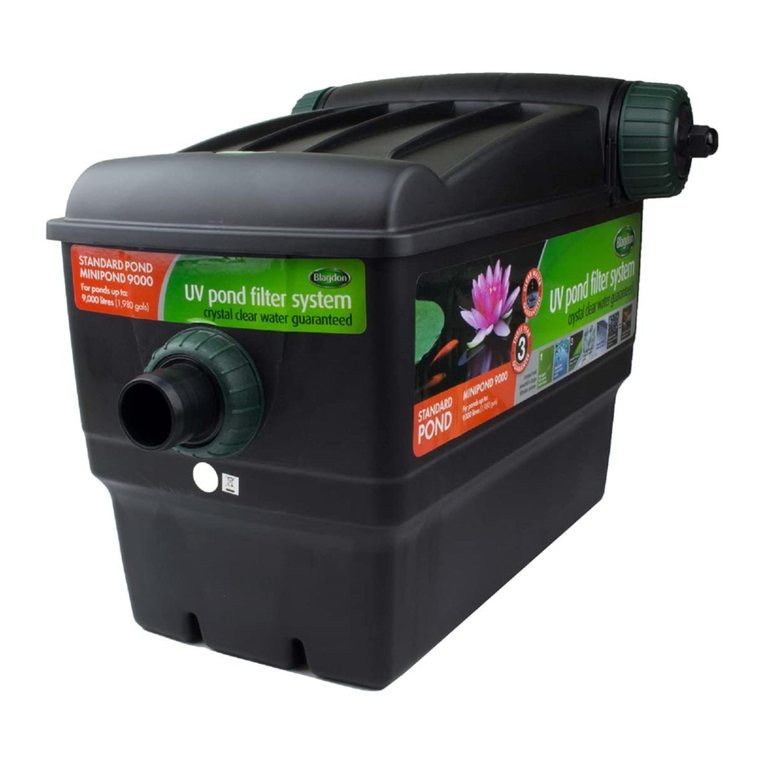
Blagdon
Blagdon Minipond 9000 manual
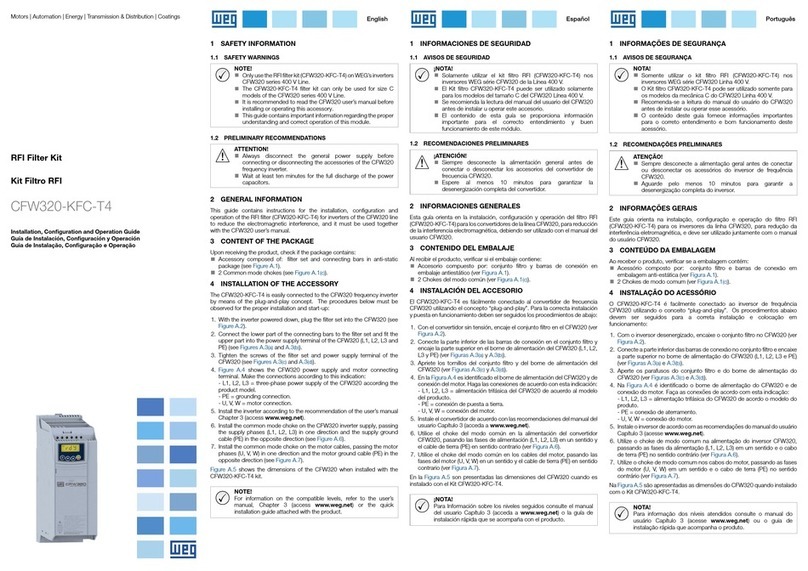
WEG
WEG CFW320-KFC-T4 Installation, configuration and operations guide
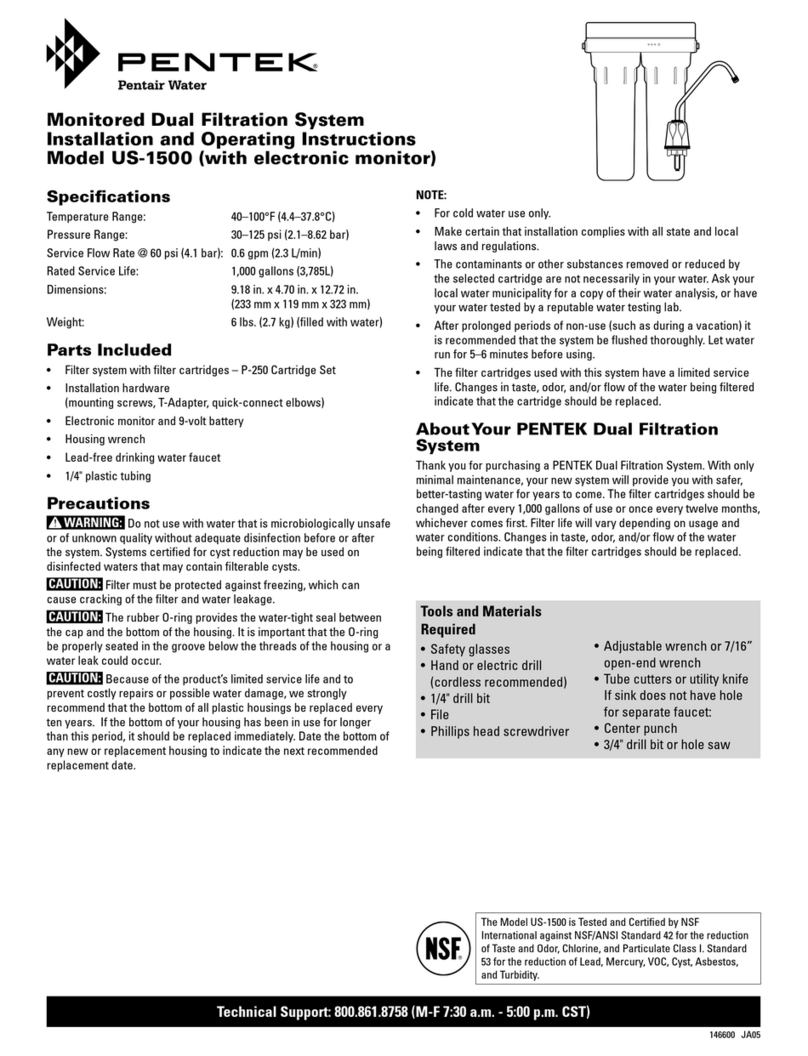
Pentek
Pentek US-1500 Installation and operating instructions
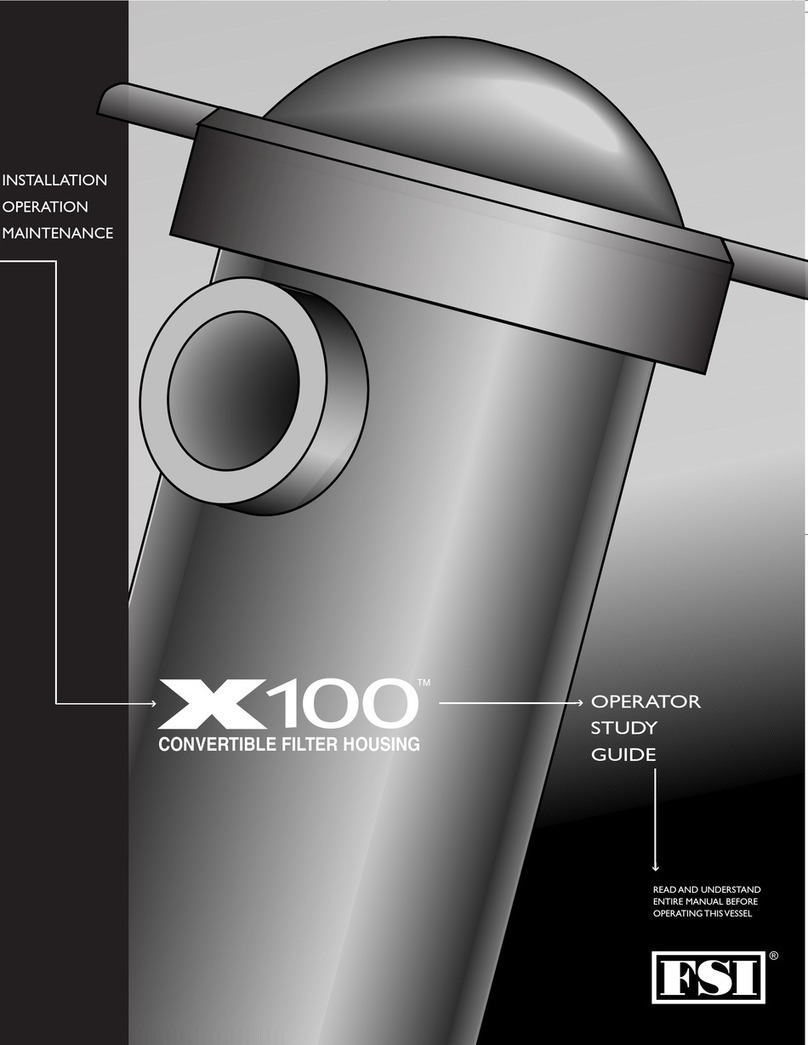
FSI
FSI x100 Operator's guide

Aqua-Excellence
Aqua-Excellence AE17 owner's manual
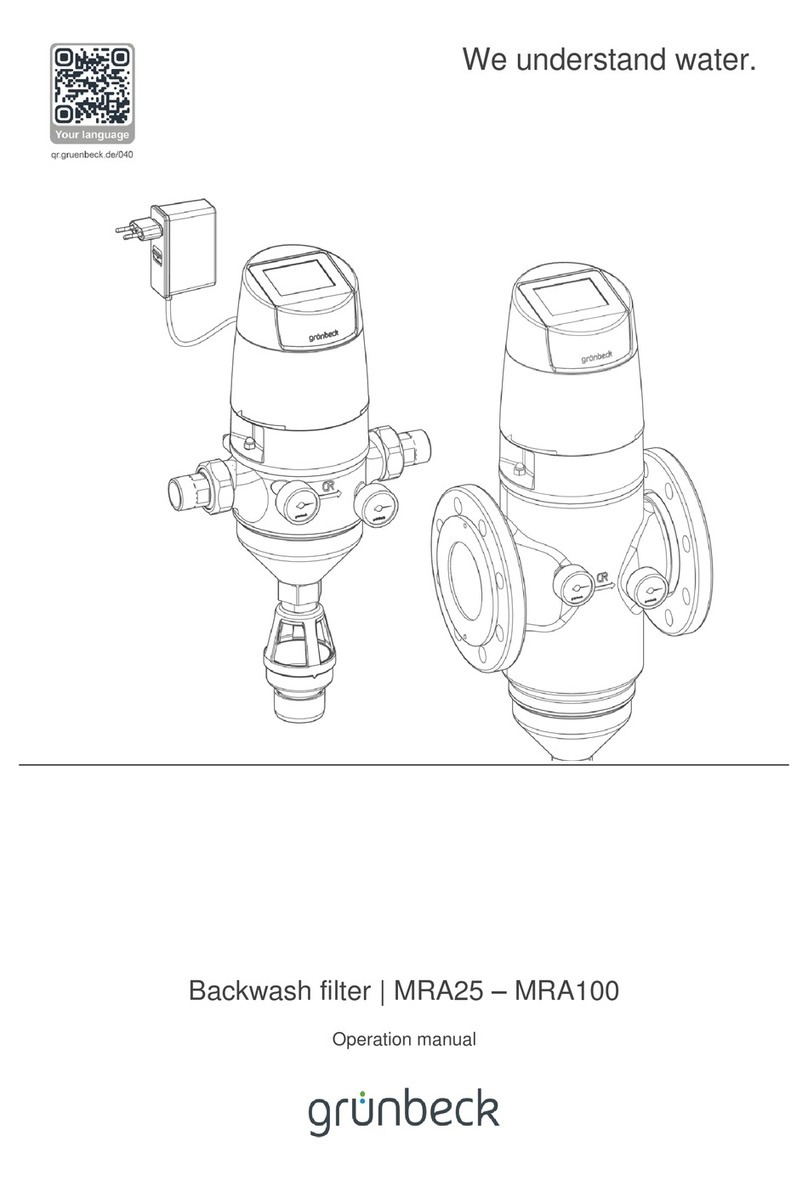
Grunbeck
Grunbeck MRA25 Operation manual

Garden Treasures
Garden Treasures MF750 manual

Aseptico
Aseptico AA-17-HEPA instruction manual
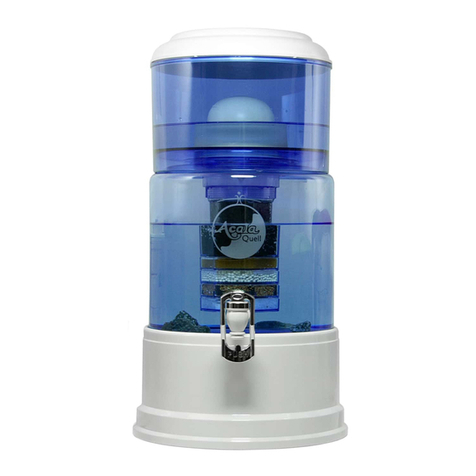
AcalaQuell
AcalaQuell Smart user manual
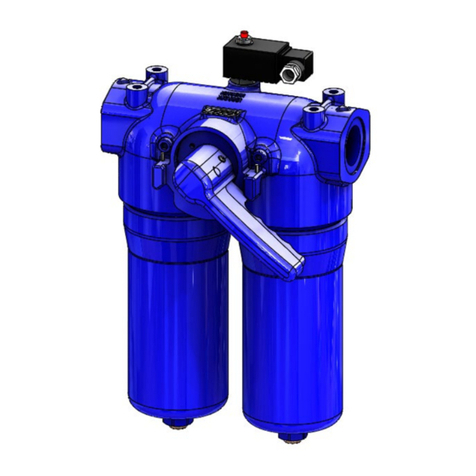
Filtration Group
Filtration Group Pi 21430 Translation of the original instructions
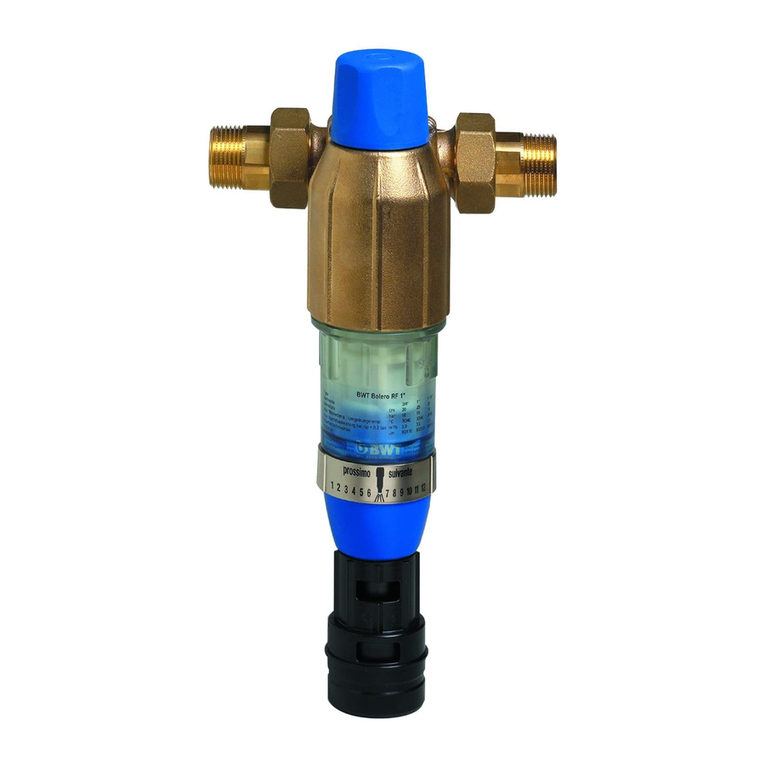
BWT
BWT Bolero RF Installation and operating manual
